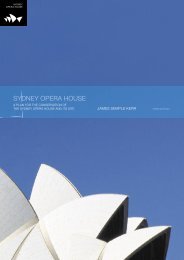nomination by the Government of Australia - Sydney Opera House
nomination by the Government of Australia - Sydney Opera House
nomination by the Government of Australia - Sydney Opera House
You also want an ePaper? Increase the reach of your titles
YUMPU automatically turns print PDFs into web optimized ePapers that Google loves.
In <strong>the</strong> <strong>Sydney</strong> <strong>Opera</strong> <strong>House</strong> Jørn Utzon realised <strong>the</strong> great syn<strong>the</strong>sis <strong>of</strong> earth and<br />
sky, landscape and city, vista and intimacy, thought and feeling, in terms <strong>of</strong> a<br />
unity <strong>of</strong> technological and organic form. Hence we may safely say that <strong>the</strong> <strong>Sydney</strong><br />
<strong>Opera</strong> <strong>House</strong> represents a masterpiece <strong>of</strong> human creative genius, and a most<br />
significant step in <strong>the</strong> history <strong>of</strong> modern architecture (Norberg-Schulz 1996: 172).<br />
Utzon’s design was an exceptional response to <strong>the</strong><br />
harbour setting. He drew heavily from his childhood<br />
exposure to shipbuilding and his experiences as a sailor.<br />
He also studied sea charts <strong>of</strong> <strong>Sydney</strong> Harbour, explored<br />
<strong>the</strong> qualities <strong>of</strong> <strong>the</strong> promontory at Bennelong Point<br />
from photographs and pictures, visited various harbour<br />
environs in Denmark and Sweden and studied Greek<br />
sites from aerial photographs. ‘It is a mark <strong>of</strong> his genius<br />
that he so brilliantly interpreted <strong>the</strong> location, <strong>the</strong> light<br />
and <strong>the</strong> landscape with its sculptural forms’ (Murray<br />
2004: 1). The outstanding success <strong>of</strong> <strong>the</strong> building today<br />
is in large part due to <strong>the</strong> way it is grounded in <strong>the</strong><br />
site: ‘It appears to rise out <strong>of</strong> <strong>the</strong> ground as a landform<br />
almost as though it were a geological extension <strong>of</strong> <strong>the</strong><br />
earth itself’ (Frampton 2004: 21).<br />
Utzon’s design was also a brilliant response to <strong>the</strong><br />
cultural purpose <strong>of</strong> a performing arts centre, a place<br />
that excites <strong>the</strong> human imagination. It did not just<br />
provide a new performing arts venue but <strong>of</strong>fered <strong>the</strong><br />
dream <strong>of</strong> a cultural centre for <strong>the</strong> city, a place in which<br />
<strong>the</strong> imaginative life and culture <strong>of</strong> <strong>the</strong> people might<br />
fl ourish. It is today as Utzon envisaged it in 1959 when<br />
he predicted: ‘The <strong>Sydney</strong> <strong>Opera</strong> <strong>House</strong> will perform<br />
its own exciting drama on <strong>the</strong> harbour’ (<strong>Australia</strong>n<br />
Heritage Commission 1980: Appendix 1).<br />
3.6<br />
Figure 3.6 The <strong>Sydney</strong> <strong>Opera</strong> <strong>House</strong> is a brilliant response<br />
to its maritime setting.<br />
It is largely due to <strong>the</strong> cultural excitement generated<br />
<strong>by</strong> its sculptural form that <strong>the</strong> <strong>Sydney</strong> <strong>Opera</strong> <strong>House</strong> is<br />
one <strong>of</strong> <strong>the</strong> busiest performing arts centres in <strong>the</strong> world.<br />
In 2004 <strong>the</strong> <strong>Sydney</strong> <strong>Opera</strong> <strong>House</strong> hosted over 1700<br />
performances for more than one million <strong>the</strong>atre patrons,<br />
while an estimated three million more people were<br />
drawn to <strong>the</strong> site to closely examine its form. The Swiss<br />
architectural historian Sigfried Giedion wrote:<br />
One must see <strong>the</strong> <strong>Sydney</strong> <strong>Opera</strong> <strong>House</strong><br />
as a totality, and above all, how it fulfi ls its<br />
human purpose. Its only goal is to prepare<br />
<strong>the</strong> audience for a festival. Whoever visits<br />
<strong>the</strong> <strong>the</strong>atre at Delphi in Greece, high above<br />
<strong>the</strong> sanctuaries, must fi rst experience a long<br />
slow climb up <strong>the</strong> winding sacred way. In<br />
<strong>the</strong> <strong>the</strong>atre itself he fi rst experiences <strong>the</strong> full<br />
majesty <strong>of</strong> <strong>the</strong> landscape. On a smaller scale,<br />
something similar is attempted at <strong>Sydney</strong><br />
(Giedion 1965: 44).<br />
One <strong>of</strong> <strong>the</strong> great architectural contributions <strong>of</strong> <strong>the</strong><br />
<strong>Sydney</strong> <strong>Opera</strong> <strong>House</strong> is <strong>the</strong> introduction at a civic<br />
scale <strong>of</strong> <strong>the</strong> podium as a means <strong>of</strong> affording views<br />
<strong>of</strong> <strong>the</strong> surrounding landscape. The podium <strong>of</strong>fers<br />
continuity with <strong>the</strong> peninsular landscape and also<br />
functions as a ceremonial stage, a high altar to <strong>the</strong> arts<br />
and culture <strong>of</strong> <strong>Australia</strong>.<br />
3.7<br />
Figure 3.7 The <strong>Sydney</strong> <strong>Opera</strong> <strong>House</strong> is also an outstanding<br />
response to its cultural purpose.<br />
31

















